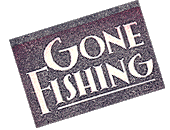|
Today,
Tony also sells homes from a real estate office in Youngsville, New York and Linda
sells antiques and collectibles from her shop in Milford, Pennsylvania.
But plying the river in his McKenzie drift boat between Hancock, New York
and the Lackawaxen searching for rainbow trout, shad, smallmouths,
walleyes, striped bass and an occasional tiger muskie is his first love.
As
he relaxed between trips last week, Ritter, 39, said he's probably more in
love with the river now than he was when he first saw it and began to
explore it in 1984.
A "tailwater" river without a dam in its 200-mile length from
the Pepacton and Cannonsville reservoirs to the Delaware Bay, the Delaware
is "truly a remarkable river," the guide observed.
Clean,
swift, scenic, with all kinds of fish and wildlife and only an hour or two
from major metropolitan centers in New York, New Jersey and Pennsylvania,
the river is amazing, he added.
Ritter said he enjoys sharing his enthusiasm for the Delaware and environs
with all his customers -- whether they be out for a day's fishing or
simply to see the river valley from the river, itself -- and says he's
surprised that so many know so little about the river that he has come to
call almost a second home.
An
artist, Ritter was -- and continues to be -- drawn to the river not only
by its scenic beauty in every season but for |
the
complete and total release it offers. Like painting, writing or
sculpturing, matching wits with the finny denizens of the river demands
total absorption and dedication.
It's
something that appeals to every age and every stage of life he has found
as he propels his shallow-drift boat from one fishing spot to another. No
motor for him.
The package for one or two clients includes lunch and a chance of fish
from land that shore-bound anglers would never be able to reach. The
dory-shaped, fiberglass boat with its high sides and flat bottom draws
only a few inches of water and is able to get to many places semi-v boats
can't. Plus it's built to withstand the roughest water, having been
designed for Alaskan fishing.
Ritter is licensed by the National Park Service and the DEC to guide
fishermen only, and only on the 75-mile stretch of the Upper Delaware
between the Roebling Bridge and Hancock, having learned through his own
experience and by asking a lot of questions.
Indeed,
he was 28 when he and his wife bought their home on Little Lake Erie in
Narrowsburg, the old George Oellrich place, and from that point on he
began to learn all he could about the river form local folks who'd lived
with it all their lives.
For him, the hours he spent away from work fishing and learning the lore
of the river were almost like a second childhood. He discovered shad and
striped
|
bass
who have fought their way upriver for 300 miles from the Atlantic Ocean to
lay their eggs where they, themselves, were born years before.
He
would catch rainbow trout, the wild descendants of a trainload of trout
fry the Erie Lackawanna Railroad had to dump in the Callicoon Creek nearly
a century ago when one of their trains derailed near Callicoon.
He would learn to tie flies to catch trout and shad with the best of them
and he eventually became so proficient that the very people who had taught
him what they knew would encourage him to become a guide so he could pass
that knowledge on to others.
And so, for Ritter, guiding on the Delaware has become a mission as well
as a livelihood, a way to introduce many others to the joys of sport
fishing and living on the upper reaches of the Delaware.
"Whether you're a dyed-in-the-wool fisherman, nature enthusiast,
wildlife photographer or first-time visitor looking for a different
perspective of the Upper Delaware River Valley, we'll do our best to
provide you with a day you'll remember for many years to come," he
promises.
Ritter remembers that day 11 years ago when he saw the river and its
valley for the first time. Now he's sharing that initial delight and
learning even more with each new trip.

|